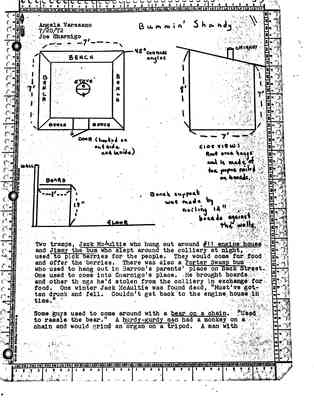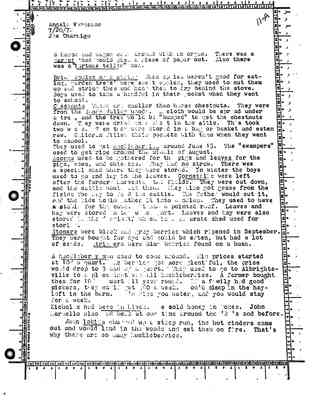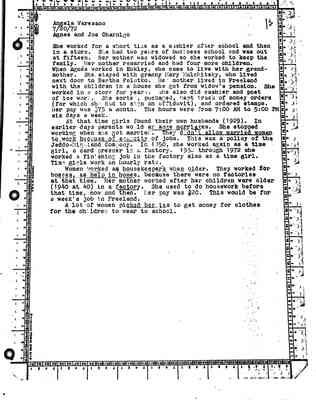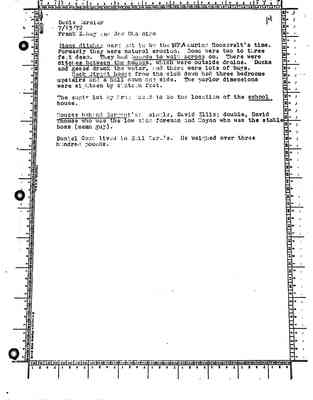Pages
page_0013
Angela Varesano 7/20/72 Joe Charnigo
[Note: This is a page titled "Bummin' Shandy" with three small drawings on the top half of the page and typed text on the bottom half.]
"Bummin' Shandy"
The first drawing is at the top of the page on the left side. It is square, with the length and width of its sides described as 7 feet. Inside the square is drawn a slightly smaller square. There is a line drawn from each corner of the smaller to the same corner of the larger square, with "45 degree corners angles" written near the top right corner. The spaces between the two squares on the left, top, and right sides are labeled "BENCH". Between the bottom edge lines of the squares, two vertical lines are drawn near the middle that are identified as "DOOR (hooked on outside and inside)", with "BENCH" written on either side of the door. To the right of this drawing is one that is described as "SIDE VIEW: Roof over hangs and is made of tar paper nailed on boards." It shows the side-view of the building, which is trapezoid in shape. Its left side is 8 feet and the right side 7 feet in height, causing the roof to tilt downward toward the right side. There is a small round cylinder labeled "CHIMNEY" protruding from the top. The base of the building is 7 feet in width. The third drawing is below the first one, and depicts a cross-section of a bench. To the left is the "WALL", represented by two close vertical lines, closed by a small jagged line across their tops and ending at a horizonal line at the bottom labeled "floor". About a third of the way from the top of the wall are two close horizonal lines labeled "BOARD", described as 1 foot in width and projecting to the right of the wall. There is a line from the right edge of the board to the floor, showing a distance of 18 inches from the top of the board to the floor. To the right of the drawing is the information "Bench support was made by nailing 12 inch boards against the walls." [The text below is the typed portion of the page] Two tramps, Jack McAultie who hung around #11 engine house and Jimmy the bum who slept around the colliery at night, used to pick berries for the people. They would come for food and offer the berries. There was also a Porter Swamp bum who used to hang out in Barron's parents' place on Back Street. One used to come into Charnigo's place. He brought boards and other things he'd stolen from the colliery in exchange for food. One winter Jack McAultie was found dead, "Must've gotten drunk and fell. Couldn't get back to the engine house in time." Some guys used to come around with a bear on a chain. "Used to rassle the bear." A hurdy-gurdy man had a monkey on a chain and would grind an organ on a tripod. A man with
page_0014
Angela Varesano 7/20/72 Joe Charnigo
a horse and wagon came around with an organ. There was a parrot that would pick a piece of paper out. Also there was a "fortune teller" man.
Dried apples on a string. When apples weren't good for eat-ing, garden trees' were sweet apples, they used to cut them up and string them and hang them to dry behind the stove. Boys used to take a handful in their pocket when they went to school.
Chestnuts. These are smaller than horse chestnuts. They were from the Sandy Valley woods. A cloth would be spread under a tree, and the tree would be "bumped" to get the chesnuts down. They were dried on a chest in the attic. This took two weeks. Then they were stored in a bag or basket and eaten raw. Children filled their pockets with them when they went to school.
They used to get huckleberries around June 15. The "swampers" used to get ripe around the middle of August.
Acorns used to be gathered for the pigs and leaves for the pigs, cows, and chickens. They had no straw. There was a special shed where they were stored. In winter the boys used to go and lay in the leaves. Cornstalks were left after the farmer harvested the fields. They were cut down, and the cattle would eat them. They also got grass from the fields for hay to feed the cattle. The father would cut it, and the kids would father it into bundles. They used to have a stable for the cows. It had a pointed roof. Leaves and hay were stored in the upper part. Leaves and hay were also stored in the "hayloft," which was a separate shed used for storage.
Stoners were black and gray berries which ripened in September. They were bought for dye and could be eaten, but had a lot of seeds. Strippers were blueberries found on a bush.
A huckleberry man used to come around. His prices started at 10 cents a quart. As the berries got more plentiful, the price would drop to 3 and 4 cents a quart. They used to go to Albrightsville to a place that was all huckleberries. A farmer bought them for 10 cents a quart all year round. If a family had good pickers, they could get $60 a week. You'd sleep in the hay loft in the barn. They'd give you water, and you would stay for a week.
Nicholas had bees in hives. He sold honey in boxes. John Marmello also had bees at one time around the '20's and before.
When lokies chugged up a steep run, the hot cinders came out and would land in the woods and set them on fire. That's why there are so many huckleberries.
page_0015
Angela Varesano 7/20/72 Agnes and Joe Charnigo
She worked for a short time as a cashier after school and then in a store. She had two years of business school and was out at fifteen. Her mother was widowed so she worked to keep the family. Her mother remarried and had four more children. When Agnes worked in Eckley, she came to live with her grandmother. She stayed with granny Mary Mulchitsky, who lived next door to Bertha Falatko. Her mother lived in Freeland with the children in a house she got from widow's pension. She worked in a store for years. She also did cashier and post office work. She sorted, packaged, kept track of money orders (for which she had to sign an affidavit), and ordered stamps. Her pay was $75 a month. The hours were from 7:00 AM to 5:00 PM six days a week.
At that time girls found their own husbands (1929). In earlier days parents would arrange marriages. She stopped working when she got married. They didn't allow married women to work because of scarcity of jobs. This was a policy of the Jeddo-Highland Company. In 1950, she worked again as a time girl, a card presser in a factory. 1952 through 1972 she worked a finishing job in the factory also as a time girl. Time girls work an hourly rate.
Women worked as housekeepers when older. They worked for bosses, as help in homes, because there were no factories at that time. Her mother worked after her children were older (1940 at 40) in a factory. She used to do housework before that time, now and then. Her pay was $20. This would be for a week's job in Freeland.
A lot of women picked berries to get money for clothes for the children to wear to school.
page_0016
Angela Varesano 6/13/72 Joe Charnigo
Wood for homes were obtained from a forest down in the area that is not covered with coal dirt. This is located by Emil Gera's.
Rent was $5 for a Back Street home. Back Street had cheaper, older homes. These homes looked like Mrs. Timko's house, small.
Main Street is where Irish people lived. If Slavs walked on Main Street, they "got chased in the old days by Irish."
All families lent chickens, pigs and geese for food. Cabbages, potatoes, etc. were planted for food. The whole yard was used for planting. With these and a hundred pound bag of flour, you will be all set; you had all you needed to eat.
The ambulance was drawn by mules. The mules and ambulance were housed in the mule stable. This was located across from Fatula's and across the street from where the general store used to be.
The doctor was called for on magneto phones. Miners in the adjourning chamber would hear of the accident and go to help. An empty car was used to carry the victim up. This required a "special trip" for that car. It wasn't hitched to a full coal car trip. The "owl hole" was worked with an electric motor. He remembers how one night shift a man was killed, and they had to help him in the first aid shandy all night until the coroner came.
Every night both boys and men had teams. They used to play in the field up near the road "going to the church."
Catholics were buried at St. Anne cemetary in Freeland. They were of the early Eckley churches. There were two other "grey" colored churches which he remembers, one of which was built in 1893.
He went to school in the school house near the church. The school was built in 1910. It was grey "like the church," and had six teachers. Each room had steam heat from a radiator. The three rooms on the first floor held the first three grades, the second floor held the fourth through sixth. There was also a library upstairs. In the basement were six toilets-six for boys and six for girls. The stalls had doors that swung open in the middle. There was a janior to keep the place. The rooms were done in mahogany woodwork,
page_0017
Denis Mercier 7/13/72 Frank Zahay and Joe Charnigo
Stone ditchers were put in by the WPA during Roosevelt's time. Formerly they were natural erosion. Some were two to three feet deep. They had boards to walk across. There were ditches between the houses, which were outside drains. Ducks and geese drunk the water, and there were lots of bugs.
Back Street homes from the club down had three bedrooms upstairs and a hall down one side. The parlor dimensions were eighteen by sixteen feet.
The empty lot by Frank used to be the location of the school house.
Houses behind Sturgent's: single, David Ellis; double, David Thomas who was the low side foreman and Noyon who was the stable boss (mean guy).
Daniel Coxe lived in Emil Gera's. He weighed over three hundred pounds.




